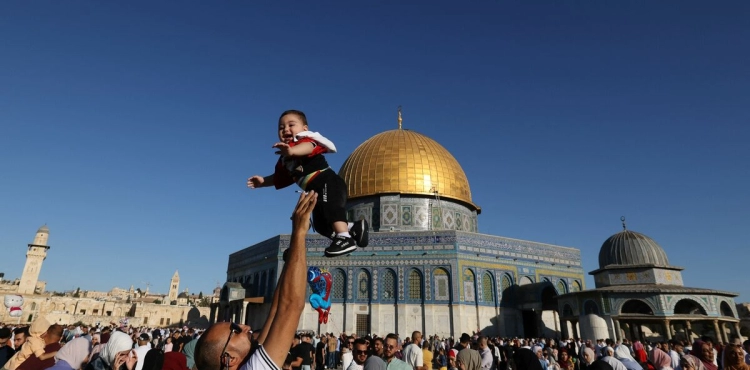Palestinians in Jerusalem, the Gaza Strip and the West Bank celebrated the blessed Eid al-Adha , amid an atmosphere of joy, especially among children and boys who wore new clothes.
Tens of thousands of worshipers in the cities and camps of the Strip, including women and children, flocked to mosques and public squares to perform the Eid prayer and listen to the sermon that urged the need for Palestinian reconciliation and an end to the state of division.
Acting Speaker of the Palestinian Legislative Council Ahmed Bahr said during the Eid sermon at the Palestine Mosque, west of Gaza, that the Palestinian people are able to thwart all Israeli plans, through unity and adherence to rights and constants, stressing that the Palestinians will not allow the passage of “any deals that undermine their rights and cause.” ".
Bahr called on the Palestinian people to rejoice on the holiday, "despite the Israeli measures and the siege imposed on the Gaza Strip for 15 years, and the pain and distress that the population suffers from due to the economic conditions."
In turn, a member of the Hamas Political Bureau, Khalil al-Hayya, called during the Eid prayer sermon in Al-Saraya Square in the center of Gaza City, to unite, support and heal wounds, noting that the countries that normalize their relations with Israel "will fail to deviate the compass from Palestine."
After the end of the Eid prayer, the Palestinians flocked to the sacrificial slaughter center, where they are distributed into three sections, one third for relatives, one third for the poor, while one third is kept for the family, according to the Islamic Sunnah.
Despite the atmosphere of joy, some sadness permeated the audience, as a Palestinian youth was killed, due to a head injury, while lowering a calf in the city of Khan Yunis in the southern Gaza Strip.
Medical sources said that the young man, Abdel Raouf Safi, died of a head injury while lowering a calf.
Safi was transferred to Nasser Hospital in a critical condition due to the injury, and the doctors tried to save his life in the operating room, but he died.
Despite this, the residents of the Gaza Strip practiced their annual custom of exchanging visits to offer congratulations on the occasion of Eid, while children and boys, accompanied by their families, visited the parks and playgrounds in the Strip in an effort to express the joy of Eid and search for entertainment.
During the daytime hours of Eid, civil institutions and others concerned with orphans´ affairs hold celebrations for children in a number of public squares, punctuated by music, songs and acrobatic performances.
Dozens of other families were also keen to visit the graves of their relatives who were martyred during the past years.
The atmosphere was not different in the cities, towns and villages of the West Bank, where Eid prayers were held in public squares, stadium floors, and mosques.
The most prominent scenes were thousands of Palestinians flocked to the Ibrahimi Mosque in the city of Hebron to perform prayers despite the Israeli procedures and obstacles.
Hebron Mayor Taysir Abu Sneineh told reporters, "Despite the Israeli restrictions and the continuation of measures aimed at Judaizing the Haram and changing its features, we will remain steadfast on our land, and we will perform our prayers in our pure Islamic mosque."
Abu Sneineh called on the residents of the city to intensify their presence in the Ibrahimi Mosque to protect it, pointing out that thousands of people performing the Eid prayer in the compound constitutes the biggest blow to the Israeli plans aimed at Judaizing it.
The Ibrahimi Mosque is the oldest holy building in use until today, almost without interruption, in the West Bank, and it is the fourth holy place for Palestinian Muslims.
On the other hand, Jews believe that the Ibrahimi Mosque, or what they call “the Cave of Al-Makhbela,” is the place where the prophets Abraham, Isaac, Jacob and their wives were buried. After occupying the West Bank, Israel established a synagogue inside the courtyards of the compound.
Members of the Executive Committees of the Palestine Liberation Organization and the Central Committee of the Palestinian National Liberation Movement (Fatah) laid wreaths at the tomb of the late Palestinian President Yasser Arafat at the presidential headquarters in Ramallah on the occasion of Eid al-Adha.
"We have come today to lay wreaths at the shrine of the symbol of this nation, and the symbol of this struggle march, Yasser Arafat," Fatah Vice President Mahmoud al-Aloul told reporters.
Al-Aloul pointed out that "Israeli crimes have recently intensified, whether against land through appropriation, or against people through killings and executions, stressing that this reality "must not continue, and the coming days will bear other positions that will constitute an attempt to solidify the Palestinian position."
In the same context, about 150,000 Palestinians from Jerusalem, the West Bank and the occupied interior performed the Eid prayer in the courtyards of the blessed Al-Aqsa Mosque.
Those present shouted the Eid takbeer, while others exchanged congratulations, and some distributed sweets at the doors of the mosque, while volunteers distributed toys to children in the chapel of the Dome of the Rock.
The Palestinian flag decorated the atmosphere of the feast in the courtyards of the mosque. At the end of the prayer, the worshipers went to the “Al-Yusufiya” and “Al-Rahma” cemeteries in the “Al-Asbat” gate, one of the doors of the mosque, to visit the Muslim cemeteries, as was the custom on the feast.
Palestinian Hani Arafa, who is in his fifties, accompanied his children, said that the atmosphere of the feast in the city of Jerusalem is beautiful and wonderful, expressing his hope that security and peace will prevail in the city, away from any Israeli inconveniences.












